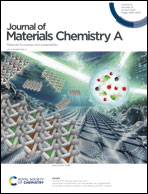Initial SEI formation in LiBOB-, LiDFOB- and LiBF4-containing PEO electrolytes†
Abstract
A limiting factor for solid polymer electrolyte (SPE)-based Li-batteries is the functionality of the electrolyte decomposition layer that is spontaneously formed at the Li metal anode. A deeper understanding of this layer will facilitate its improvement. This study investigates three SPEs – polyethylene oxide:lithium tetrafluoroborate (PEO:LiBF4), polyethylene oxide:lithium bis(oxalate)borate (PEO:LiBOB), and polyethylene oxide:lithium difluoro(oxalato)borate (PEO:LiDFOB) – using a combination of electrochemical impedance spectroscopy (EIS), galvanostatic cycling, in situ Li deposition photoelectron spectroscopy (PES), and ab initio molecular dynamics (AIMD) simulations. Through this combination, the cell performance of PEO:LiDFOB can be connected to the initial SPE decomposition at the anode interface. It is found that PEO:LiDFOB had the highest capacity retention, which is correlated to having the least decomposition at the interface. This indicates that the lower SPE decomposition at the interface still creates a more effective decomposition layer, which is capable of preventing further electrolyte decomposition. Moreover, the PES results indicate formation of polyethylene in the SEI in cells based on PEO electrolytes. This is supported by AIMD that shows a polyethylene formation pathway through free-radical polymerization of ethylene.

- This article is part of the themed collection: Today's Simulations: Pioneering the Experiments of Tomorrow


 Please wait while we load your content...
Please wait while we load your content...